
Sentry 3.0 Documentation
Last Revised: March 2013
 |
|
Options
Click the Options item from the Sentry menu to change program settings, layouts, and user accounts.
General Security Accounts Layouts Network Away Message ScreenSavers Logging Notes SentryBar Remote Notify Advanced Deployment
General
Check for Updates: Checks Fresh Software’s website on startup for a newer version of Sentry. There are three settings: Disabled (do not check for updates), Notify me of new releases (Check for major releases) and Notify me of new releases and betas.
Startup Mode: Determines how Sentry should launch when Windows starts.
Do Not Run on Windows Startup - Sentry will not launch on Startup. A user must launch Sentry.
Run on Windows Startup (Normal) - Sentry will launch on Windows startup by using the Run key in the registry. Your desktop may be briefly visible while Sentry loads normally with other Windows startup programs.
Run on Windows Startup (Before Explorer) - Sentry will launch itself before your desktop or start menu are visible. NOTE: This option works fine on Windows XP, but on Windows Vista and Windows 7, Sentry must be run as an administrator, and with UAC (User Access Control) off for this to work properly.
Enable automatic lockdown after XXX seconds - When the box is checked, Sentry will lock your desktop after a period of inactivity (when Sentry is idle in the System tray)
Sentry Launch Hotkey: Here you can define a hotkey to lock your desktop, while Sentry is running in the system tray. The default is Ctrl-Alt-S.

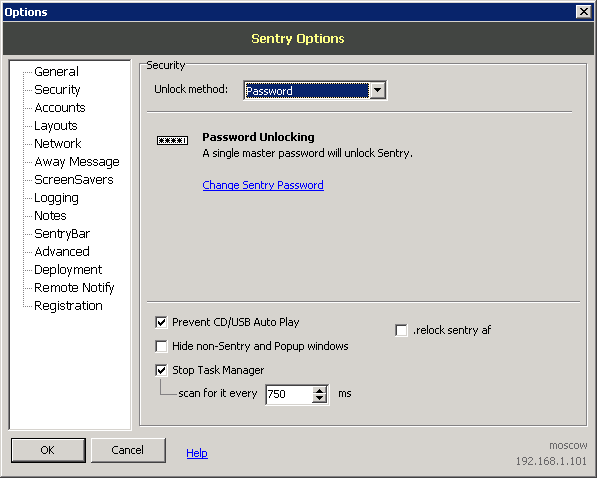
Prevent CD/USB Auto Play - Temporarily disables the execution of AutoRun code while Sentry is running.
Hide non-Sentry and Popup windows - If a new window pops up while Sentry is locked, Sentry will minimize it.
Stop Task Manager - Minimizes any instaces of Task Manager that may be invoked by Ctrl-Alt-Del when Sentry is not run as an Administrator on Windows Vista or Windows 7.
Scan for it every XXX ms --- specifies how often, in milliseconds, Sentry should check to see whether Task Manager has been invoked.
Use Windows Lock on Startup - Activates the default Windows lock screen on top of the Sentry lock screen.
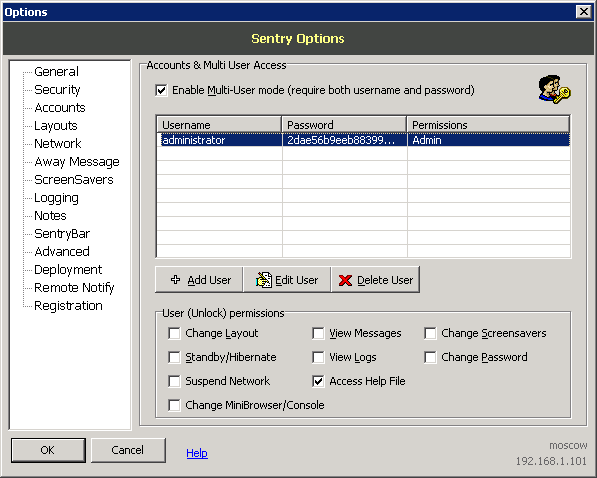
Enable Multi-User mode -- Turns on multi-user mode, where Sentry must be unlocked with a username & password, as opposed to a password alone.
Note: When using a multi-user layout (a layout with a username and password field), this box should be checked.
User permissions
Define the permissions that are given to non-administrative users of Sentry.
Change Layout - user can change the Sentry layout file.
Standby/Hibernate - user can access power-saving features from the Sentry menu
Suspend Network - user can suspend and resume computer's network access
Change MiniBrowser/Console - user can switch between the MiniBrowser and system console on the Sentry Bar.
View Messages - user can check messages/notes that have been left at the computer.
View Logs - user can view Sentry log files
Access Help File - user can read this Sentry documentation
Change ScreenSavers - user can activate a screensaver from the screensaver menu.
Change Password - user is allowed to change their password.
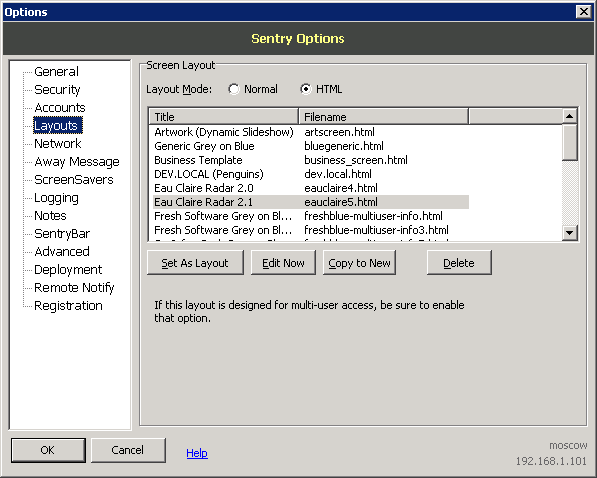
Layout Mode -- switches between SLF and HTML layouts.
Set As Layout - makes selected layout the default Sentry layout.
Edit Now - edits the layout code. For SLF, a text editor is opened. For HTML, the default Windows HTML editor is opened.
Copy to New - Duplicates the layout.
Delete - Deletes the layout from the hard drive.
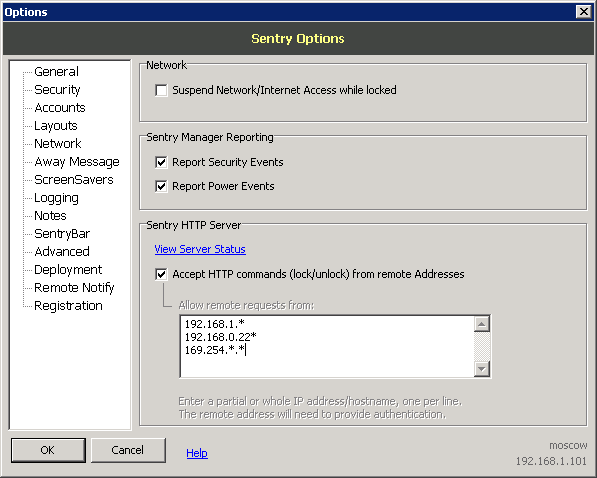
Suspend Network Access while locked -- when enabled, Sentry will suspend your network access through Windows networking commands, and re-enable it when Sentry unlocks. In Windows Vista and Windows 7, this will only work when the program is run as an Administrator. Using this option will obviously interefere with remote-control from Sentry Manager.
Report Security Events -- Reports Security Events (such as an invalid password) on this computer back to Sentry Manager.
Report Power Events -- When a computer is going offline because of a standby or hibernation event, it is reported to Sentry Manager.
Sentry HTTP Server
Accept HTTP commands from remote addresses -- when checked, Sentry will allow other IP addresses to issue commands to the computer, if that IP address provides credentials (username & password) to do so.
Allow remote requests from -- Here you can define which IP addresses Sentry will accept commands from. You may use the asterisk (*) as a wildcard to allow multiple addresses within a netblock.
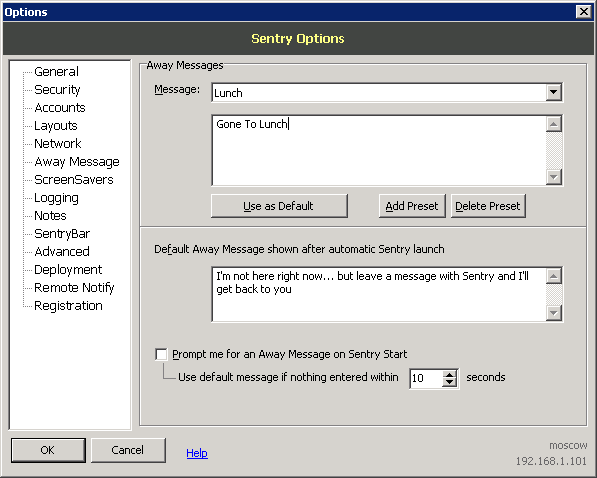
Message: -- a dropdown list that shows your away message presets. The message text is loaded into the box, where it can be edited.
Use as default -- turns the currently selected message preset into the default away message.
Add/Delete Preset -- adds or removes currently selected preset from the list of available choices.
Default Away Message: The away message that is displayed in the layout, if the layout file says that one should be displayed.
Prompt me for an Away Message on Sentry Start -- when checked, Sentry will ask you to type in an away message as you leave your computer. If nothing is entered within a certain time period, Sentry will use the default away message.
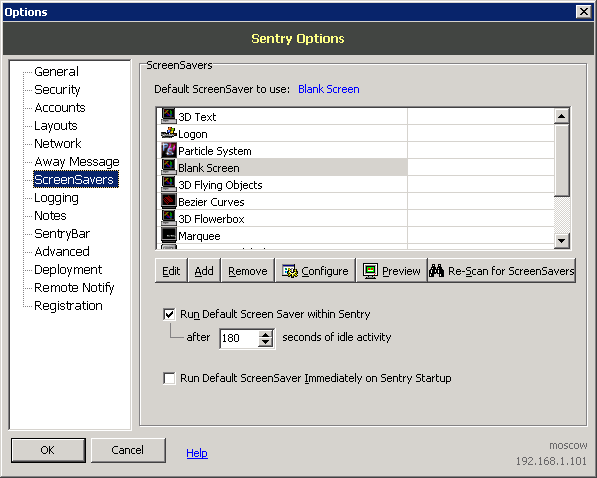
Displays a list of available screensavers to display within Sentry. To change your default screensaver, click it in the list.
Edit -- Edits the specifics of this screensaver.
Add -- Manually add a screensaver that wasn't detected earlier.
Remove -- Removes a screensaver from the list of available choices.
Configure -- Activates the currently selected screensaver's configuration dialog, if one is available.
Preview -- Runs the screensaver , previewing it until the mouse is moved.
Re-Scan for ScreenSavers -- Runs the Sentry screensaver detection tool, and rescans your computer for installed screensavers.
Run Default Screen Saver within Sentry -- When checked, Sentry (in its locked-down state) will activate the default screensaver after a certain amount of inactivity.
Run Default ScreenSaver Immediately on Startup -- Runs the default screensaver right after locking down the computer.
In this section, tell Sentry what you would like written to the log file:
Sentry Start
Sentry Start
Bad Password Attempts
CD or USB insertion
Log Sentry Lock/Unlock
Record Username of who unlocked Sentry
Sentry Exit
Notes left for the user
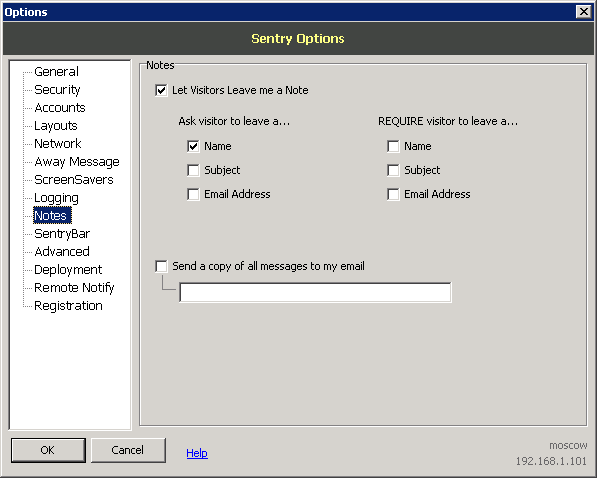
Let Visitors leave me a note -- When checked, Sentry can take messages from people who stop by your computer when it is locked down.
Ask visitor to leave... when the Name, Subject, or Email Address boxes are checked, Sentry displays these fields to the visitor leaving the note.
Require visitor to leave .... when these boxes are checked, the visitor cannot leave a note until they fill in the fields.
Sent a copy of all messages to my email -- when checked and filled with an email address, Sentry will email you a copy of each note as it is left.
* Note: This feature is not enabled in the initial release of Sentry 3.0.
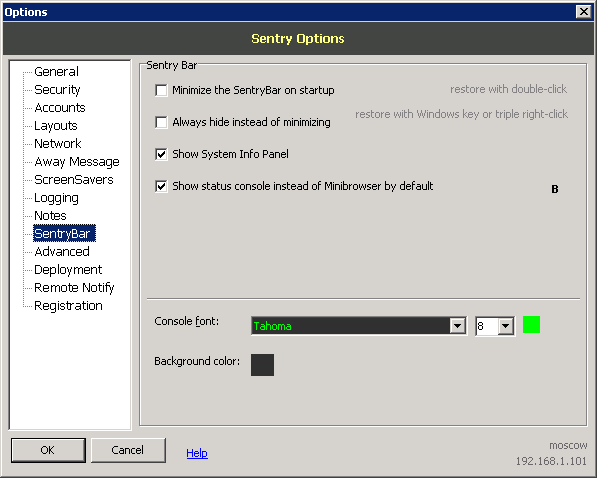

Minimize the SentryBar on startup - When checked, the Sentry Bar becomes a small bevel on the bottom of the screen. It can be restored to full size with a double click.
Always hide instead of minimizing - When checked, any action to minimize the Sentry Bar hides it completely instead. It can be restored by using the Windows key, or a triple right-click.
Show System Info Panel -- Displays the small panel on the right side, that reports the current time, the idle time, cpu usage, and the power source of the computer.
Show status console instead of Minibrowser -- When checked, Sentry starts by displaying the Status Console, vs the Minibrowser.
Console Font – Picks the font face, the size, color and style of the font used the console.
Background Color -- Determines the background color of the Sentry Bar. Click to change.
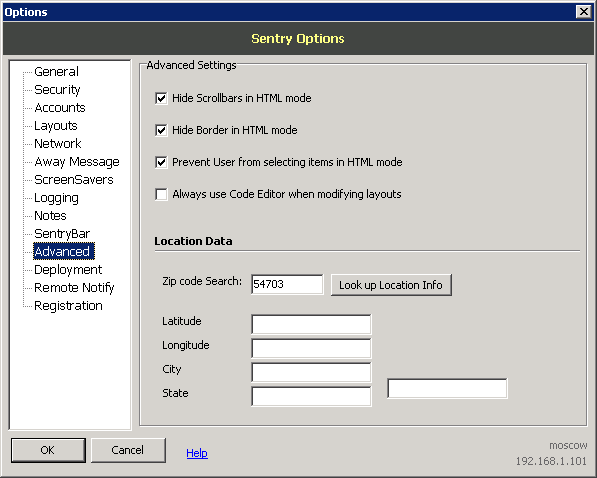
Hide Scrollbars in HTML mode -- Turns off scrollbars when using HTML layouts.
Hide Border in HTML mode -- Keeps the layout border-free.
Prevent User from selecting items in HTML mode -- When on, the user cant highlight text in the layout.
Always use Code Editor when modifying layouts -- When on, the internal text editor is used to edit HTML layouts, instead of the default Windows HTML editor.
Prompt to make Sentry disc on USB insertion -- When on, Sentry will ask you to create a USB key when Sentry is locked and a USB drive is inserted.
Minimize All Windows before Locking -- When on, Sentry will mimize all windows before loading the lock screen.
Mute Navigation Sounds -- When on, clicks inside the HTML layout will not generate a sound.
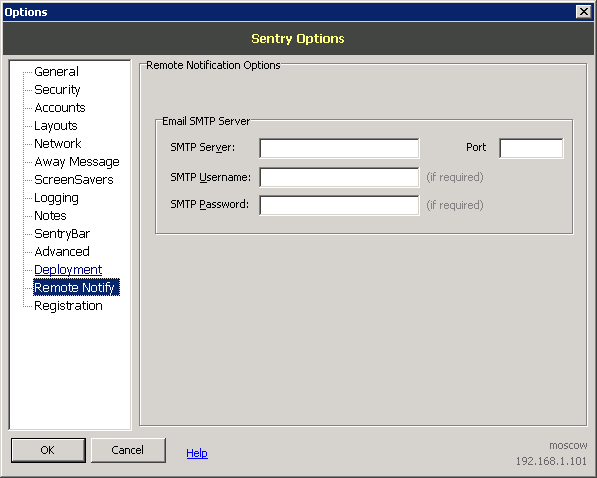
This section contains SMTP settings that are not used in the initial release of Sentry 3.0.
For remote notification, you can use Sentry Manager in conjunction with the Master IP setting.
SMTP email server – The outgoing email server to use when sending an email triggered by a rule.
SMTP username – If a username is needed to send email on this server, specify it here.
SMTP password – If a password must accompany a username, specify it here.
Show splash screen – Shows the X-NetStat splash screen on startup.
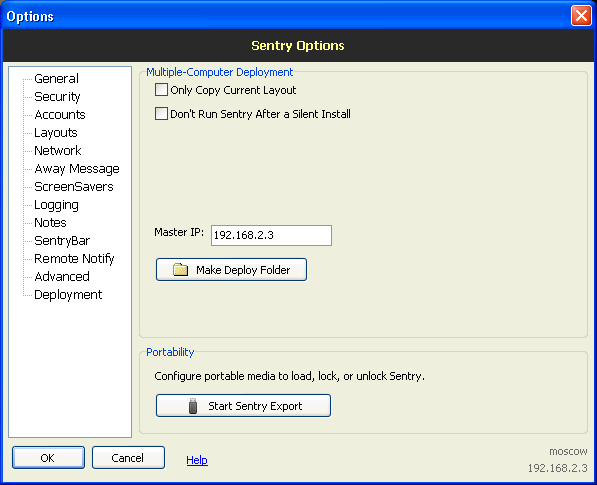
Only Copy Current Layout -- When creating a deploy folder, only copies the current layout. This means clone copies of Sentry will only have access to that layout. When unchecked, all layouts from the current computer are copies to the deploy folder.
Don't Run Sentry After a Silent Install - When checked, and Sentry is cloned onto another computer via the silent install method, Sentry will not run afterwards.
Master IP: The IP address of the administrator computer running Sentry Manager. Cloned copies of Sentry report events back to this IP address.
Start Sentry Export -- Opens the Sentry Export Dialog to put Sentry on removeable media.